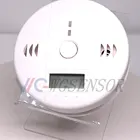In recent years, the importance of carbon monoxide (CO) detectors in households has become increasingly evident. Carbon monoxide, often referred to as the “silent killer,” is a colorless, odorless gas that can be produced by faulty appliances, heating systems, and even vehicles in enclosed spaces. The necessity of having a carbon monoxide detector in every home cannot be overstated, as it plays a crucial role in safeguarding the well-being of families.
Carbon monoxide poisoning is a serious and potentially fatal threat that can affect anyone, regardless of age or health. It is essential for individuals to understand the risks associated with CO exposure and take proactive measures to mitigate them. The installation of a carbon monoxide detector is a simple yet effective step towards creating a safer home environment.
One of the key reasons for the necessity of carbon monoxide detectors is the insidious nature of the gas. Unlike other household hazards, carbon monoxide is virtually undetectable without specialized equipment. This makes it particularly dangerous, as individuals may not be aware of its presence until symptoms of poisoning appear. Early symptoms can mimic those of common illnesses, such as headaches, dizziness, and nausea, making it challenging to diagnose the issue without the aid of a detector.
Furthermore, CO poisoning can have severe consequences if not addressed promptly. Prolonged exposure can lead to more severe symptoms, including confusion, unconsciousness, and, in extreme cases, death. Vulnerable populations, such as children, the elderly, and individuals with pre-existing health conditions, are at a higher risk of suffering from the adverse effects of carbon monoxide exposure.
Installing a carbon monoxide detector is a cost-effective and straightforward way to mitigate these risks. These devices are designed to alert residents when CO levels reach a dangerous threshold, providing valuable time for evacuation and intervention. Modern detectors are user-friendly, requiring minimal maintenance and offering peace of mind to homeowners.
Experts recommend placing carbon monoxide detectors in key areas of the home, such as bedrooms and living spaces, and near potential sources of carbon monoxide, such as furnaces, water heaters, and stoves. Regular testing and battery replacement ensure the continued effectiveness of these devices, making them a reliable safeguard for households.
In conclusion, the necessity of carbon monoxide detectors in homes cannot be overstressed. With the potential for life-threatening consequences, the installation of these devices is a small yet impactful investment in the safety and well-being of families. As awareness grows, it is crucial for individuals to prioritize the inclusion of carbon monoxide detectors in their homes, fostering a culture of prevention and protection against this silent but deadly threat.


Please contact us for free quotation by form below. We promise the quickest response within 24 hours: